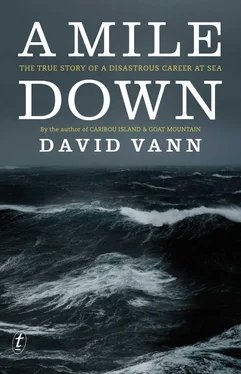“This is not necessary, David,” he said. “All these boats here use this system.”
I hated to sound like a jerk, but his explanation didn’t matter. “I don’t care if these other boats want to blow up,” I said.
“None of these boats blow up. You do not know this system.”
“Seref. Propane is heavier than air and can ignite from a spark after collecting in any enclosed space. No amount of tradition can change science.”
So Seref took the tack he usually did when he hit a wall, which was to argue that even if I wanted this change, it wasn’t possible in the design and with how much time we had. It was the same approach he took with the anchor and the exhausts to the engines and various other items.
“Where does this tank go?” he asked. “There is no place for it out there.”
We finally put it under the captain’s seat on deck, which made the seat too high. So the days ground on, filled with anger and disappointment, and if I had had a way out of the whole business, I would have taken it. But the owners before me had spent $250,000 and received only $100,000 of the $140,000 I had paid. That’s what happens when you try to sell a boat that is still under construction. You lose a lot of money. I was locked in to finishing and then using the boat successfully. That was the only way I would be able to pay everyone back.
LAUNCH DAY FINALLY arrived. Traditionally, we should have been sacrificing an animal — a goat, I think. But I said no. I was also supposed to give big tips to everyone, for luck, but I didn’t have the money. I walked around the boat with Nancy and wished we’d had more time. It would have been better to complete everything before launching.
I kept staring at the name on the stern. It had been a lovely gift from Seref, a varnished wooden plaque carved by a friend of his in Bodrum, but I worried that all of its bolts through the steel would cause corrosion.
The name itself was odd, too: The Wife of Bath . My company was Canterbury Sails, offering educational pilgrimages, as it were, beginning with writing workshops. But no one understood the name, especially in foreign countries. My Turkish crew couldn’t even pronounce it. And I wasn’t sure the sign was lined up quite right. It was hard to tell. The sun was very bright off the white hull.
The boat would be pulled backward into the water on large wooden skids. It was an old system, with cables attached fore and aft. Planks were laid out behind the boat like railroad ties for the skids to slide over.
“We use this system for hundreds of years,” Seref said. “Not with steel cable or tractor, of course. But this is same system.”
“It’s the system the Easter Islanders used to move around those huge statues,” I said. “At least according to one theory. But other scientists say the system couldn’t have worked, that the statues would have fallen off.”
Seref shook his head and smiled. “You think like no other person,” he said. Then he patted my shoulder and walked away.
By around noon, the yard crew was finally ready, and the tractor, revving up, started pulling. There were shouts immediately, then readjustments to the skids, then movement again. The whole thing looked dangerously top-heavy, but the skids moved smoothly over the ties, and after about fifty feet, the stern hanging over the edge of the water, the tractor eased up and the boat stopped.
I was inspecting the cable system. It was anchored ahead of where the bow had been, and had a brake on it, using blocks. Seref told me the next step would be to ease the boat toward the water, then let it go so that it slid back without tipping over. If they hit the brakes once it was back at an angle, it would fall onto the stern. So they had to let it glide at the end.
“I’m very nervous about this,” I said. “The launch basically is not controlled. Has a boat ever fallen over backward or sideways?”
“David, really you worry too much. This happen maybe once or twice. But almost all the time the boat just glide into the sea.”
We would be up on deck when the boat was let go. Seref and Nancy and I, and the crew. So at least Seref was risking his own life. I asked him whether our Turkish insurance policy would cover an accident at launch, and he said it would. And there was no other solution. I couldn’t make a 150-ton travelift suddenly appear.
After various final preparations had been made, about ten people were up on deck and I was down in the bilges, checking. In the engine room I found Ecrem not doing anything about two large holes in the side of the hull. They were going to be exhausts for the generator and one of the discharge pumps; the holes were about three inches in diameter. I tried to motion for him to close them, using made-up sign language since he didn’t speak English and I didn’t speak Turkish. Finally I had to yell for Seref, and he came down to interpret.
“Please tell him to close these holes,” I said.
Seref talked with him and then said, “He can’t close them. These exhausts will not have valves. The hoses will fit over the pipe.”
“Well we can’t launch with them open.”
Seref talked with Ecrem again. “He says they are above the waterline.”
“When we go flying back into the water, the water is going to slosh a bit, don’t you think?”
“Okay, David, okay,” Seref said. “I tell him to close this.”
“Thanks,” I said. Then I went through the rest of the engine checks while he talked more with Ecrem. I made sure the engine intake valves, diesel lines, and shaft gland cooling valves were open. This way of launching was difficult for me to accept. We’d hit the water at speed, drifting around uncontrolled and banging into other boats if we couldn’t start our engines. I knew I shouldn’t make comparisons, but in the U.S. this would never happen. On a railway or a travelift, engines are started and tested with the boat fully afloat, before the lines are cast off. I didn’t like my options here because I didn’t have any.
When I had checked everything and was back on deck, I made sure the rudder was centered and then stood at the helm, ready with the ignition switches, and asked Seref to give the order.
Seref yelled, and Nancy looked at me with fear. We were twenty-five feet off the ground, on a hundred-ton, top-heavy steel boat on thin wooden skids sliding backward without any brakes. I had no idea what was going to happen.
At first, nothing happened. Then we began moving, slowly. Then we were moving backward quickly, a feeling of enormous weight and power released. The fall was extremely far. I clung to the helm and hoped.
A huge sound of water rushing and we were in. We hadn’t tipped over. But we were still moving fast, and starting to curve back toward shore. I hit the ignition buttons for both diesels and they roared to life. I looked at the depth — fifteen feet, only about six feet of water beneath our keels. A lot of people were yelling, telling me to do all kinds of things. I looked around for other boats. I put one of the engines in forward to slow our speed and spun the helm to bring the bow around.
Something was wrong, though. We weren’t slowing down much. I gave it more power, and we didn’t seem to slow at all. There were two small boats anchored in our path behind us. Seref pushed me aside and grabbed the throttles, but he became confused, too, and was using the throttles and wheel randomly. He was lost. Then Ercan pushed him aside and the three of us fought for the wheel.
“Stop!” I yelled. “Something’s wrong with the props or engines. They aren’t responding correctly.”
“I drive,” Ercan said. “I am captain.”
“I’m the captain,” I told him. “Get away from the helm. Both of you.”
We were close to the boats, bearing down on them, completely out of control. Then I figured it out. The throttle was backward. Ecrem had mounted it backward, so that when we hit forward, we were really hitting reverse. I put the throttles in reverse (which was forward), spun to avoid the boats, and got us into deeper water.
Читать дальше












